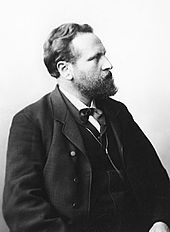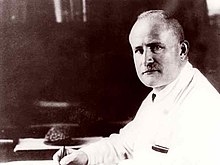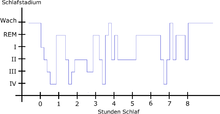Sleep research
The sleep research studied the behavior and all bodily processes and conscious processes during sleep , and the interaction between sleep and wakefulness and sleep and the environment. There is basic research ( chronobiology , metabolic processes, brain activity , dreams , learning processes ), clinical research ( sleep disorder ) and applied research ( shift work ).
Somnology is a more general term and describes the science of sleep, which includes sleep medicine as well as sleep research . A scientist who studies this area is called a somnologist.
Sleep research as a science is a relatively young branch of medicine . It only emerged after the REM phase ( R apid E ye M ovement) was discovered in human sleep in the 1950s . The World Health Organization distinguishes 88 different sleep disorders in its international classification of diseases . In addition to the fundamentals of sleep-wake regulation, these are the subject of investigation in sleep research.
For example, it was discovered that people react similarly when they are awakened in the REM (dream sleep) phase . Depending on the content of the dream, you are quickly awake and can remember a dream. When awakening from deep sleep, on the other hand, it is difficult to wake up and the test persons cannot remember dream contents as often. Today it is known that both the NONREM and the REM sleep phases are significantly involved in the long-term storage of memory contents.
The different phases of sleep can be recognized by measuring brain waves, muscle activity and eye movement and analyzing them visually or with the aid of a computer. The REM sleep is characterized by rapid salve-like horizontal eye movements, paralysis of the musculature (immobility), high brain activity and occasional convulsions .
history

In late antiquity, sleep was viewed as a balance to the waking state in the context of the sex res non naturales, which had to be observed in the diet and hygienic lifestyle . In the Middle Ages, the rules for a healthy lifestyle ( Regimen sanitatis ) also considered the relationship between sleep and nutrition and digestion. Later physiological ideas about sleep also go back predominantly to the ideas of Aristotle and Galenus .
For a long time it was assumed that sleep was a recovery phase in which the brain was simply “switched off”. As a result, sleep was thought to be homogeneous and closer examination appeared uninteresting. That changed in the middle of the 19th century. Sounds could wake sleepers, so the brain couldn't be completely shut off. The attempts to determine the "depth of sleep" from the beginnings of quantitative research into sleep are associated with the name Ernst Kohlschütter and his publication on "Measuring the firmness of sleep". His "waking stimulus method" from 1862 chose the strength of the stimulus, which leads to awakening and is known as the wake-up threshold , as a measure of the depth of sleep. The wake-up stimulus method uses a pendulum hammer that strikes a thick slate of slate as an acoustic wake-up stimulus. Kohlschütter's “sleep depth curve” showed an increasing sleep depth at the beginning of sleep over the period, which, according to the more recent view, corresponds to the first sleep cycle , and a decrease in sleep depth from then until morning.

The development of electroencephalography (EEG) made further investigations of sleep possible , with which Hans Berger , head of neurology at the Jena State Hospital, provided an important basis for somnology in 1924. Using EEG, neurological research and medical diagnostics made it possible to measure the electrical activity of the brain by recording the voltage fluctuations on the head surface, which is crucial in connection with sleep stages . Together with other procedures, the EEG is part of the most extensive examination method in the sleep laboratory , polysomnography .
An essential next step was the description of sleep stages using the EEG. Sleep researchers working with Alfred Lee Loomis classified sleep stages, then referred to as A to E, based on the features found in the EEG, such as sleep spindles. The description of the characteristics is still the basis for the classification of the sleep stages. A and B correspond to what is currently referred to as sleep stage N1, C is now N2, D and E are now N3. REM sleep has not been described. This classification was later adjusted several times, for the first time by adding REM sleep.
Eugene Aserinsky , a PhD student with Nathaniel Kleitman at the University of Chicago, was able to identify sections of sleep with rapid eye movements and higher brain activity in the EEG in which dreams occurred. With that, REM sleep was discovered. Aserinsky and Kleitman published about it in the journal Science in 1953 . Shortly before, William C. Dement had been employed as assistant to Kleitman in his sleep research experiments at the University of Washington . Dement would later provide significant impetus for sleep science and the treatment of sleeping sicknesses, especially in the USA. He helped develop the multiple sleep latency test , which assesses a person's fatigue, and has been instrumental in standardizing the diagnostic classification of sleep problems since 1975. In his book The Promise of Sleep. A Pioneer in Sleep Medicine Explores the Vital Connection Between Health, Happiness, and a Good Night's Sleep. from 1999 he summarizes fifty years of sleep research in a generally understandable way. He criticizes that even today far too few doctors have sufficient knowledge about the pathology of sleep and therefore often treat patients incorrectly. Excessive fatigue is often diagnosed as a symptom rather than the cause of various problems.
Alexander Borbély has published research on models of sleep regulation.
The American historian Roger Ekirch is considered to be the discoverer of segmented sleep. His first research, published around 2000, suggests that before the industrial revolution, it was common in much of the world, especially in Europe, to sleep in two phases. The “first and second sleep”, with a long break around midnight, was a common expression in at least 13 European languages that was completely forgotten with the introduction of artificial lighting (gas lamps, light bulbs).
literature
- Books
- Hannah Ahlheim: The dream of sleep in the 20th century. Knowledge, optimization fantasies and resistance , Göttingen: Wallstein, 2018 - History of sleep research
- Hans Berger: The human electrenkephalogram . Edited by Gerhard Mühlau. pmi-Verl., Frankfurt am Main 1991, ISBN 3-89119-184-7 .
- Stanislaw Kubicki (Ed.): Methods of sleep research ("Methods of sleep research"). Fischer, Stuttgart 1985, ISBN 3-437-10950-2 .
- Hans R. Mächler: The beginnings of modern sleep research Juris-Verlag, Dietikon 1994, ISBN 3-260-05373-5 (also dissertation, University of Zurich 1994).
- Peter Spork : The sleep book. Why we sleep and how we can best succeed . Edition Anaconda, Cologne 2011, ISBN 978-3-86647-578-6 .
- Jürgen Staedt, Dieter Riemann: Diagnosis and therapy of sleep disorders . Kohlhammer, Stuttgart 2006, ISBN 978-3-17-01-9467-0 .
- Jürgen Staedt, Yehonala Gudlowski, Marta Hauser: Sleep disorders in old age. Advice and help for relatives . Kohlhammer, Stuttgart 2009; ISBN 9783170203846
- Jürgen Staedt, Yehonala Gudlowski: Sleep and Memory or Sleep to Remember . Cognitive disorders in neurology and psychiatry. Eds. Calabrese P. & Markowitsch HJ; Hippocampus Verlag 2012.
- Jürgen Zulley : My book about good sleep . Zabert Sandmann, Munich 2005, ISBN 3-89883-134-5 .
- Magazines
- Somnology . Sleep research and sleep medicine . Springer Medicine, Heidelberg 1997 ff ISSN 1432-9123
Web links
- Regensburg Sleep Medicine Center
- German Society for Sleep Research and Sleep Medicine (DGSM)
- Austrian Society for Sleep Medicine and Sleep Research (ÖGSM)
- "Conference Sleep" - 13th Berlin Colloquium on May 27, 2009 - Lectures, presentations, background information , accessed on January 29, 2013
Individual evidence
- ^ Heinrich Schipperges †: Sleep. In: Werner E. Gerabek , Bernhard D. Haage, Gundolf Keil , Wolfgang Wegner (eds.): Enzyklopädie Medizingeschichte. Walter de Gruyter, Berlin and New York 2005, ISBN 3-11-015714-4 , p. 1298.
- ^ William C. Dement: The study of human sleep: a historical perspective . In: Thorax . Vol. 53 Suppl 3, 1998, pp. 2-7 , PMID 10193352 , PMC 1765910 (free full text) - (English).
- ↑ Ernst Otto Heinrich Kohlschütter: Measurement of the firmness of sleep . In: Journal for rational medicine . Third row, no. 17 , 1863, p. 209–253 ( PDF, 5.88 MB [accessed January 29, 2013]).
- ↑ Johannes Werner: A method for continuous sleep depth measurement in humans with the help of electrencephalo-, electrooculo- and electrocardiography (EEG, EOG and EKG) . In: Journal for all of experimental medicine . Vol. 134, No. 2 , 1961, p. 187-209 , doi : 10.1007 / BF02046290 .
- ^ Mathias Basner: Arousal threshold determination in 1862: Kohlschütter's Measurements on the Firmness of Sleep . In: Sleep Medicine . Vol. 11, No. 4 , 2010, p. 417-422 , doi : 10.1016 / j.sleep.2009.10.002 (English).
- ↑ Hans Berger: About the human electrenkephalogram . In: Archives for Psychiatry and Nervous Diseases . Vol. 87, No. 1 , 1929, p. 527-570 , doi : 10.1007 / BF01797193 .
- ^ Alfred Lee Loomis, Edmund Newton Harvey and Garret A. Hobart: Cerebral states during sleep as studied by human brain potentials . In: Journal of Experimental Psychology . Vol. 21, No. 2 , 1937, pp. 127–144 , doi : 10.1037 / h0057431 (English).
- ^ Hartmut Schulz: Rethinking Sleep Analysis . In: Journal of Clinical Sleep Medicine . Vol. 4, No. 2 , 2008, p. 99-103 , PMID 18468306 (English).
- ^ Eugene Aserinsky, Nathaniel Kleitman: Regularly occurring periods of eye motility, and concomitant phenomena, during sleep . In: Science . Vol. 118, No. 3062 , 1953, pp. 273-274 , PMID 13089671 (English).
- ^ Eugene Aserinsky, Nathaniel Kleitman: Regularly occurring periods of eye motility, and concomitant phenomena, during sleep . Emphasis. In: The Journal of Neuropsychiatry and Clinical Neurosciences . Vol. 15, No. 4 , 2003, p. 454–455 , doi : 10.1176 / appi.neuropsych.15.4.454 , PMID 14627774 (English).
- ^ William C. Dement, Christopher Vaughan: The Promise of Sleep. A Pioneer in Sleep Medicine Explores the Vital Connection Between Health, Happiness, and a Good Night's Sleep. Delacorre Press, New York NY 1999, ISBN 0-385-32008-6 ; Published in German as Sleep and our health: about sleep disorders, insomnia and the healing power of sleep ; Translation by Rüdiger Hentschel, Monika Noll and Rolf Schubert; Limes Verlag GmbH, Munich 2000; ISBN 3-8090-3019-8
